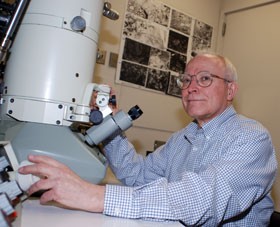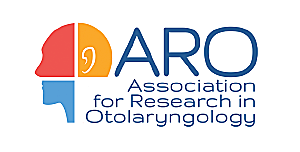 Kent Morest, M.D., (1934-2020)
Kent Morest, M.D., (1934-2020)
With profound sadness, we announce the passing of Donald Kent Morest, MD, age 86, on December 30, 2020, in Arlington, MA. Kent was a pioneer in both auditory and developmental neuroscience. He is often regarded as the father of modern auditory neuroanatomy, following in the footsteps of his muse Santiago Ramón y Cajal in exploiting the Golgi method, while also being the first to apply systematic electron microscopic analysis to studies of the auditory system. In addition, his detailed analyses of developing auditory brainstem and other parts of the brain led to important insights on neuronal migration and differentiation.
Kent was born in Kansas City, MO, the son of a physician, which may explain his early interest in medicine. In 1955, Kent received a Bachelor of Arts degree with honors from the University of Chicago. At Chicago, Kent was exposed to basic philosophical questions and an analytical approach that propelled his keen interest in research in the basic sciences. In 1960, he received his MD with honors from Yale University School of Medicine. During and after medical school, he conducted research in several internationally-known laboratories, including the Montreal Neurological Institute, University College London, and the Laboratory of Grant Rasmussen at NIH. After studying with Dr. Rasmussen, Kent decided to pursue basic neuroscience, rather than clinical science. By the age of 31 he was renowned both nationally and internationally for his work describing the organization of the medial geniculate body in the thalamus. During his time in the Rasmussen laboratory, he met Rosemary Richtmyer, who became his wife and partner in the laboratory. Together they developed an unparalleled collection of Golgi-impregnated brain sections, which formed the basis of many important studies, performed with his students and outside collaborators.
Kent’s first faculty position was at the University of Chicago (1963-1965), followed by an appointment in the Department of Anatomy at Harvard Medical School, where he remained for 12 years, rising through the academic ranks. At Harvard, his lectures to medical and graduate students were outstanding for their intensity, scholarship, and attention to detail. In departmental seminars, he was notorious for asking the critical question. His lab at Harvard bustled with a medley of students at all stages of their careers. There were also joint projects with scientists from the Eaton-Peabody Laboratory at the Massachusetts Eye and Ear Infirmary related to Kent’s long-standing, productive collaboration with its head, Dr. Nelson Kiang. Most remarkable and important to his students were Kent’s weekly lab meetings, where their ongoing research was critiqued. In 1977, Kent accepted a professorship at the University of Connecticut Health Center in Farmington, CT, where he served in the Department of Anatomy (1978-2000) and the Department of Neuroscience (2000-2012). There, he spearheaded many advances in cellular and systems neuroscience, especially auditory neuroscience.
Kent’s interest in the auditory system emerged during his fellowship years in the Rasmussen laboratory. He applied the rapid Golgi method and in subsequent years combined his Golgi studies with electron microscopy and silver degeneration to perform in-depth analyses of the neuronal architecture and synaptic organization of the major components of ascending auditory systems in the brainstem, including the dorsal and ventral cochlear nuclei, medial nucleus of the trapezoid body, inferior colliculus, and medial geniculate body. This work set the stage for physiologists to investigate central auditory signal processing at the cellular level of analysis that was the envy of other sensory system scientists. With his students, he also elucidated the innervation patterns and synaptic organization of the cochlea using both the rapid Golgi method and electron microscopy. Later, Kent applied immunocytochemical methods for key neurotransmitters, including glutamate, GABA, and glycine, to define more fully the synaptic organization and connections of the cochlear nuclei and superior olivary complex.
At UConn, Kent focused on characterizing the degenerative process in the dorsal cochlear nucleus at the cellular and molecular levels following overstimulation of the cochlea. Using patterns of axonal degeneration, he documented that peripheral auditory lesions lead to synaptic degeneration in the brain. His studies investigated the balance between excitation and inhibition of synaptic terminals in the cochlear nuclei, focusing on factors that protect or allow synapses to recover normal function after noise-induced damage. His most recent immunocytochemical studies on the auditory system included defining the expression of potassium and sodium channel subunits that change following deafferentation. Thus, throughout his career, Kent contributed cutting-edge findings that combined state-of-the-art approaches with classical neuroanatomical methods to advance our understanding of auditory system structure and function.
Kent’s work on the auditory system alone would have been sufficient for an extraordinary career. Yet, he also produced a remarkable series of papers on neuronal development, focusing on neuronal migration and differentiation of axons, dendrites and synaptic terminals in the cerebral cortex, retina, vestibular and auditory brainstem nuclei, optic tectum, and vestibular and auditory parts of the inner ear. Applying the rapid Golgi method and electron microscopic methods to understand these developing systems, he provided strong support for the concept of perikaryal translocation as a mechanism underlying neuronal migration from the site of proliferation of new neurons to their final destination in the brain. He reconfirmed the importance of growth cones for identifying growing axons and dendrites, and retraction clubs for the withdrawal of improper outgrowths. More recently, he developed innovative cultures of the cochleovestibular ganglion and brainstem to investigate the role of trophic interactions on neuronal development and maintenance. He identified the importance of basic fibroblast growth factor, brain-derived neurotrophic factor, and cell adhesion molecules in this system. In this work, he challenged developmental neurobiologists by demanding that any interpretation of a neurobiological process be based on combined structural and functional data.
One of Kent’s lasting gifts to his students was in sharing his love of the written word. He pored over every word in every manuscript, insisting that the writing be both elegant and evocative. He loved to find just the right word to characterize an anatomical structure, with the goal of bringing life to its description. His efforts to evoke the beauty of anatomical structures extended to his figures. He hoped to help the reader “gain some impression of what the impregnated cells looked like to the microscopist.” Most important, he recognized that it is the “character of the neuropil” that is crucial for understanding the structural basis for integrating inputs within different parts of the nervous system, so the neuropil became a major focus in many of his studies and illustrations.
Kent published 72 full-length papers in auditory neuroanatomy and 38 papers in developmental neurobiology. This is a prolific record, given the high level of detail found in every manuscript. He also coauthored 13 book chapters and two brain atlases. In addition to his dedication to scholarly work, he had a long history of serving with the highest distinction on study sections for NIH, NASA and NSF, editorial boards for prominent journals, and various international committees. At UConn, he founded the neuroscience area of concentration in the Biomedical Science PhD program, serving as director from 1982 to 1995. He established the Center for Neuroscience that was the predecessor of the current Department of Neuroscience and served on all major committees at UConn. Among other honors, in 1992, he was elected to the Connecticut Academy of Sciences and Engineering, and in 1992-1995, he served on the prestigious Advisory Board of the National Institute for Deafness and other Communication Disorders. According to his family, he was most proud of a Professional Achievement Citation from the University of Chicago, awarded in 2009.
In closing, Dr. D. Kent Morest was a distinguished scientist and recognized leader in the fields of neuroanatomy of the auditory system and developmental neurobiology, with a record of sustained productivity and impeccable scholarship in both. He also was a superb teacher and mentor. Former students and colleagues deeply admired his encyclopedic knowledge, quick wit, and pervasive demand for excellence. A personal obituary appeared in the Hartford Courant, January 10, 2021.
Written by:
Kenna Peusner, PhD Douglas L. Oliver, PhD
Professor of Neurology Professor and Vice-Chair of Neuroscience
George Washington University University of Connecticut School of Medicine
School of Medicine
Sonal Jhaveri, PhD Leslie P. Tolbert, PhD
Science Program Director Regents Professor Emerita in Neuroscience
Student Affairs Office University of Arizona
Dana-Farber Cancer Institute
Nell B. Cant, PhD,
Emeritus Faculty
Duke University Medical School
